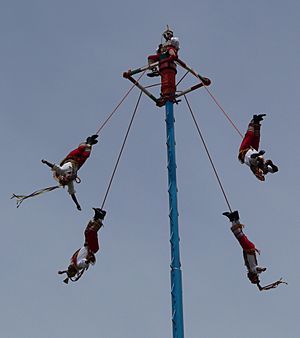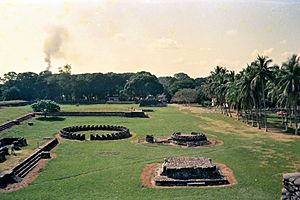Totonac facts for kids

|
|
| Regions with significant populations | |
|---|---|
| 411,266 | |
| Languages | |
| Totonac languages, Spanish | |
| Religion | |
| Indigenous Religion, Christianity | |
The Totonac are a group of native people who live in Mexico. They mostly live in the states of Veracruz, Puebla, and Hidalgo.
Many historians believe the Totonac people helped build the ancient city of El Tajín. They also had parts of the city of Teotihuacán, which some Totonac people say they built. For a long time, until the mid-1800s, they were the world's main producers of vanilla.
Contents
What Does "Totonac" Mean?
The word "Totonac" refers to the people living in a region called Totonacapan. Experts don't fully agree on where the word comes from. Some think "Totonac" is a Nahuatl word. It might mean "People of Hot Land."
In the Totonac language, some sources say "toto-nacu" means "three hearts." This could refer to their three main cities or cultural centers: Cempoala, Tajin, and Teayo. However, there isn't enough proof to be sure.
Where the Totonac Lived and How They Lived

In the 1400s, the Aztecs called the Totonac region "Totonacapan." This area stretched from Papantla in the north to Cempoala in the south. Totonacapan was usually hot and humid.
Besides common crops like corn, squash, beans, and chili peppers, the region was known for growing cotton. Even during a terrible famine in central Mexico from 1450 to 1454, Totonacapan remained a good farming area. Many Aztecs had to sell themselves or their family members as slaves to the Totonac people to get enough corn to survive.
What the Totonac Ate
The Totonac people did not use comals, metates, or manos. This means they likely did not eat tortillas. Even though they grew corn, it wasn't a huge part of their diet.
They ate a lot of fruit, like zapotes, guavas, papayas, plantains, and avocados. Men hunted and fished for shark, turtle, deer, armadillo, opossums, and frogs. Women raised turkeys and dogs.
In the morning, both farmers and nobles ate corn porridge. Lunch was the biggest meal. It included manioc, bean stew, or a rich meat sauce for nobles. Fish, seafood, and game were eaten by everyone. They also made a drink from the agave plant.
What the Totonac Wore
Totonac women were skilled at weaving and embroidery. They dressed beautifully and braided their hair with feathers. A friar named Bernardino de Sahagún said that Totonac women were "quite elegant."
Women wore skirts, which were embroidered for nobles, and a small triangular poncho. Noble women wore necklaces and earrings made of shell and jade. They often tattooed their faces with red ink. Married women styled their hair like the Nahuatl people. Peasant women wore their hair long.
Noble men also dressed well. They wore colorful cloaks, loin cloths, necklaces, and arm bands. They also had lip plugs and decorations made from the valuable quetzal feathers. Men kept their hair long, with a thick tuft on top tied with a ribbon.
Totonac Homes
Totonac houses were usually rectangular. They had thatched roofs and an overhang.
Totonac History
From the mid-1400s until the Spanish arrived, the Totonacapan region faced attacks from the Aztecs. Even though the Aztecs built forts there, the Totonac often rebelled.
Important Totonac cities included Papantla, with about 60,000 people in 1519. Xalapa had around 120,000 people, and Cempoala had about 80,000. Cempoala was the first native city Hernán Cortés visited on his way to the Aztec capital of Tenochtitlán.
The Totonac people of Cempoala joined forces with Cortés. Along with the Tlaxcalan Indians, they greatly helped the Spanish conquer the Aztecs. The Totonac region became part of the Spanish rule with little fighting. However, many people died from new diseases during the 1500s. Today, about 90,000 people still speak Totonac in the region.
Totonac Language
The Totonac people traditionally speak Totonac. This language, along with Tepehua, forms a small language family. This means Totonacan languages are not related to other native Mesoamerican languages. These include languages like those in the Mayan, Oto-Manguean, or Uto-Aztecan families.
There are several different kinds of Totonac spoken. They are so different that people speaking one kind might not understand another. The first descriptions of Totonac for Europeans were written by Fray Andrés de Olmos. He also wrote the first descriptions of Nahuatl and Huastec.
The main types of Totonac are:
- Papantla Totonac: About 80,000 people speak this in places like El Escolín, Papantla, Cazones, Tajín, Espinal, and other towns along the Gulf Coast of Veracruz.
- North-Central Totonac: Spoken roughly between Poza Rica in Veracruz and Mecapalapa, Pantepec, and Xicotepec de Juárez in Puebla.
- South-Central Totonac: Mostly spoken in the Sierra Norte de Puebla. This includes towns like Zapotitlán de Méndez, Coatepec, and Huehuetla in Puebla.
- Misantla Totonac: Fewer than 500 people speak this. They live in Yecuatla and other communities near the city of Misantla, Veracruz.
Totonac Religion
Most Totonac people today are Roman Catholic. However, their Christian practices often mix with parts of their old traditional religion. One example is la Costumbre. This is an old sacrifice ritual. In it, different seeds are mixed with earth and the blood of birds. This mixture is then spread over planting fields.
The traditional Totonac religion was studied in the early 1960s by a French expert named Alain Ichon. Not many other major studies on Totonac religion have been found. Mother goddesses were very important in Totonac beliefs. They believed that each person's soul was made by these goddesses. If a newborn child died, its soul "does not go to the west, the place of the dead, but to the east with the Mothers."
Ichon also recorded an important myth about a corn god. This god is a culture hero, similar to gods in other cultures along the Gulf Coast. This god might also be shown by the Classic Maya maize god.
People believed that traditional healers "are born during a storm, under the protection of thunder." They thought that a lightning bolt would strike the house of a new baby. This would make the baby "under its possession." Other known gods include Chichiní (the sun) and Aktzin.
See also
 In Spanish: Pueblo totonaca para niños
In Spanish: Pueblo totonaca para niños


